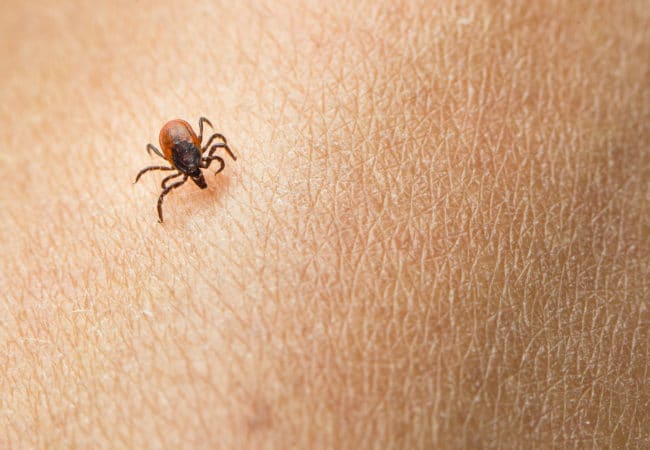Summer is here and the urge to be outdoors is stronger than ever but don’t let the love of outdoors come with a price.
According to the Ohio Department of Health, there were 270 human cases of Lyme disease in 2017. A year prior they reported 160 human cases. The number could potentially be even higher this year.
“Unlike fleas, ticks can survive harsh winters in their dormant state,” said Brittany Bockanic, a veterinarian at Crago Veterinary Clinic. “Since there are more ticks, specifically deer ticks, likelihood of infection with Lyme disease is much higher as well.”
The month with the most reported cases in Ohio is August and the Ohio counties with the most reported cases include Carroll, Coshocton, Harrison and Jefferson.
The disease is carried by ticks and can be contracted by humans and animals through a tick’s bite.
Matthew Lehnert is an entomologist at Kent State University’s Stark campus. He said there are currently over 900 species of ticks worldwide and most of these species fall into two groups: hard ticks, or Ixodidae, and soft ticks, or Argasidae.
Lehnert said hard ticks are what Ohioans are most familiar with. Types of hard ticks include American dog tick, blacklegged tick and Lone Star tick.
The Ohio Department of Health describes these vector ticks or ticks that transmit the disease as the blacklegged tick or deer tick. The younger, smaller blacklegged ticks are most likely to give the disease to humans because they often go unnoticed.
If a tick happens to latch on to a person or pet, the Centers for Disease Control reports the tick must remain attached for 36 or more hours for the disease to be transmitted.
If the disease is successfully transmitted, there are symptoms that appear. The Cleveland Clinic news service described some of the symptoms such as a low-grade fever, fatigue and a red rash that looks like a bull’s-eye.
For pets, symptoms may take up to a week to appear. Bockanic said when the symptoms do appear, the joints and kidneys of the pet are most affected.
“Some dogs get pain in their joints and are reluctant to move,” Bockanic said. “There is a form that can affect the kidneys causing increased thirst and urination, protein in the urine and loss of appetite.”
Along with Lyme disease, Bockanic said ticks can also carry diseases Anaplasmosis and Ehrlichiosis. Anaplasmosis and Ehrlichiosis have similar symptoms as Lyme disease and are very curable but can be fatal if left untreated.
The similar symptoms of these diseases can make it hard for a person to determine what they’ve contracted. Dr. Michael Paronish, a family-medicine specialist at Mercy Health, said this is why it’s important to seek a doctor’s advice.
“Symptoms are vague and may overlap with many other types of illnesses,” Paronish said. “It is strongly recommended to discuss these symptoms with a trained professional to help determine the exact cause.”
Paronish broke down avoiding Lyme disease into three parts: first is avoiding high- risk areas, second is removal, and third is using antibiotic protection.
Lehnert suggested when trying to avoid ticks while outdoors, be wary or stay away from wooded areas, unmowed regions with tall grass and forest edges. These are areas where ticks are most prevalent. These would be considered high-risk areas.
“When traveling in high-risk areas and enjoying the great outdoors, perform regular tick checks to remove unwanted hitchhikers before they become attached,” Paronish said. “Ensure that a full body tick check occurs at least daily, thus nearly eliminating your risk.”
The antibiotic prevention step is for those who believe they’ve had a tick attached to them for more than 36 hours and if this tick was an adult or nymph deer tick.
Cleveland Clinic Infectious Disease Specialist Alan Taege proposed a few ways to avoid contact with ticks in an online article released by Cleveland Clinic Newsroom. The most important, Taege said, was applying bug spray.
Taege also mentioned wearing long sleeves and pants and even tucking the bottom of pants into shoes. This is Taege’s advice no matter where a person is outdoors; camping, hiking or just in the backyard.
Unfortunately, the deer tick does not have a tell. Lehnert said there are no real signs that a tick is carrying Lyme disease prior to being bit.
“If someone is concerned that a tick is carrying Lyme disease the best thing to do is to first identify the tick,” Lehnert said. “Lyme disease is rare, so if a person finds a tick feeding on them, or a parent finds one on their child, it is best to not panic.”
To determine tick type, Lehnert said look for a presence or absence of patterns on the tick’s backside. The deer tick is most likely to transmit Lyme disease in the nymph stage. In this stage, the tick has eight legs, brown or black in color and is as small as the size of a pin-head.
Lyme disease is still avoidable if the tick is removed within 36 to 48 hours. Seeking medical attention is one way to get the tick removed but if medical help is not available in a person’s circumstance, the removal can be done at home.
“The proper way is to grasp with fine tweezers or gloved fingers as close to the mouthparts as possible and apply steady pressure straight upwards until the tick releases,” Paronish said. “Do not burn, irritate or cut the tick or skin.”
Lyme disease should be treated seriously but a chart of human cases of Lyme disease since 2008 from the Ohio Department of Health has recorded zero deaths from the disease.
“Lyme disease is rare and is treatable,” Lehnert said. “In order for the bacterium to be transmitted from the tick to the host, the tick has to usually feed for at least 24 hours and usually ticks are detected and removed before transmission occurs.”
For further information about ticks, Lyme disease and preventative tips, visit odh.ohio.gov… cdc.gov… or tickencounter.org….
Pets and Lyme disease
To protect indoor animals from Lyme disease, it may be important to keep away outside animals from the home.
Though ticks transmit the disease, they become carriers after feeding on different rodents such as mice. They then move on to feed on deer, hence deer tick.
The CDC recommends building a fence around the house to keep away any unwanted animals.
Veterinarian Brittany Bockanic of Crago Veterinary Clinic said it is also important to get pets vaccinated to help prevent Lyme disease. The vaccines aren’t perfect and can’t always stop Lyme disease but if a pet does get in infected and has been vaccinated, Bockanic said symptoms of the disease may be less severe.
Lyme disease affects an animal’s joints thus creating the symptom of sluggishness but this symptom and others can also mean other diseases.
If a veterinarian does diagnose a pet with Lyme disease, Bockanic said the next step would be to treat it with an antibiotic called doxycycline. If symptoms persist, it would then be treated through pain management, fluid therapy and diet change.
To avoid going through all of this hassle, it’s important to check pets that are frequently outside daily. If a tick is found, The Humane Society offers a few steps for removing it:
• With gloves and a pair of clean tweezers, Grasp the tick as close to your dog’s skin as possible (without pinching your pet).
• Pull it out in a straight, steady motion. Anything left behind could lead to an infection.
• Place the tick in isopropyl alcohol and mark the date it was found so it can be tested by a vet if symptoms appear.
• Clean the pets wound with antiseptic.
© 2018 Metro Monthly. All rights reserved.





